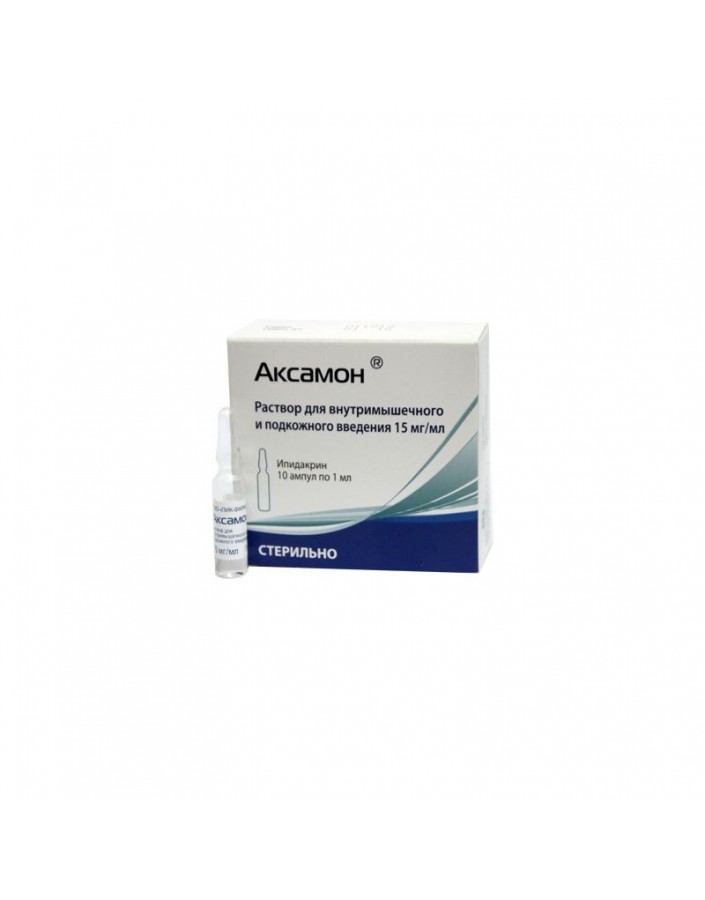




Security policy (edit with Customer reassurance module)

Delivery policy (edit with Customer reassurance module)

Return policy (edit with Customer reassurance module)
- diseases of the peripheral nervous system: mono- and polyneuropathy, polyradiculopathy, myasthenia and myasthenic syndrome of various etiologies;
- diseases of the central nervous system: bulbar paralysis and paresis, the recovery period of organic lesions of the central nervous system, accompanied by motor impairment;
- intestinal atony.
The drug is injected s / c or / m. Dose and duration of treatment are determined individually, depending on the severity of the disease.
Peripheral nervous system diseases
Mono- and polyneuropathy of various origins, polyradiculopathy: p / c or / m 5-15 mg 1-2 times / day, a course of 10-15 days (in severe cases - up to 30 days); then the treatment is continued with a pill form of the drug.
Myasthenia gravis and myasthenic syndrome: P / C or / m 15-30 mg 1-3 times / day with a further transition to the pill form. The general course of treatment is 1-2 months. If necessary, treatment can be repeated several times with a break between courses of 1-2 months.
CNS diseases:
Bulbar paralysis and paresis: p / c or / m 5-15 mg 1-2 times / day, a course of 10-15 days; then, if possible, switch to pill form;
The recovery period of organic lesions of the central nervous system, accompanied by motor disorders: V / m 10-15 mg 1-2 times / day, a course of up to 15 days; then, if possible, switch to pill form.
Treatment and prevention of intestinal atony: Initial dose - 10-15 mg 1-2 times / day for 1-2 weeks.
The frequency of adverse reactions that may occur during the use of the drug is given in the form of the following classification: very frequent (> 1/10 prescriptions), frequent (1 / 10-1 / 100 prescriptions), infrequent (1 / 100-1 / 1000 assignments), rare (1 / 1000-1 / 10 000 assignments), very rare (<1/10 000 assignments) and an unspecified frequency (the frequency cannot be calculated from the available data).
From the psyche: infrequent - drowsiness.
From the nervous system: infrequent - dizziness, headache, convulsions; Unspecified frequency - tremor.
On the part of the organ of vision: Unassigned frequency - miosis.
From the side of the heart: frequent - palpitations, bradycardia; Unspecified frequency - pain behind the sternum.
On the part of the respiratory system: infrequent - enhanced secretion of bronchial secretions.
From the digestive tract: frequent - drooling, nausea; infrequent - vomiting; rare - diarrhea, pain in the epigastrium.
Liver and biliary tract: Unspecified frequency - jaundice.
Dermatological: infrequent - itching, rash.
Other: frequent - increased sweating; infrequent - general weakness; Unknown frequency - hypothermia.
Salivation and bradycardia can be reduced by m-anticholinergics (including atropine, cyclodol, metacin).
In the event of an itch or rash, you should stop taking the drug. In other cases, reduce the dose or briefly (1-2 days) interrupt the drug.
- epilepsy;
- extrapyramidal disorders with hyperkinesis;
- angina pectoris;
- severe bradycardia;
- bronchial asthma;
- mechanical obstruction of the intestine or urinary tract;
- vestibular disorders;
- peptic ulcer of the stomach or duodenum in the acute stage;
- children's age up to 18 years (there is no systematic data on the use of children);
- Hypersensitivity to any of the components of the drug.
with caution prescribed at gastric ulcer and duodenal ulcer, thyrotoxicosis, cardiovascular diseases, obstructive diseases of the respiratory system in history or acute diseases of the respiratory tract.
Use during pregnancy and lactation
The use of the drug increases the tone of the uterus and can lead to premature birth, therefore, ipidacrine is contraindicated in pregnancy.
Data on the use of the drug during breastfeeding are not available.
Contraindicated in children under 18 years of age (there is no systematic data on the use of children
Influence on ability to drive motor transport and control mechanisms
During treatment, one should refrain from driving, other vehicles and mechanisms, as well as from engaging in potentially hazardous activities that require increased concentration of attention and quickness of psychomotor reactions.
Symptoms: loss of appetite, bronchospasm, lacrimation, increased sweating, constriction of pupils, nystagmus, increased gastrointestinal motility, spontaneous defecation and urination, vomiting, jaundice, bradycardia, intracardiac conduction disturbance, arrhythmias, reduction of blood pressure, anxiety, arousal, arousal, disturbance, aphoria, arousal, aeration convulsions, coma, speech disorders, drowsiness and general weakness.
Treatment: use of m-holinoblokatorov (including atropine, cyclodol, metacin), symptomatic therapy.
Aksamon® increases the sedative effect in combination with drugs that depress the central nervous system.
The effect and side effects are enhanced when combined with other cholinesterase inhibitors and m-cholinomimetic agents. In patients with myasthenia, the risk of a cholinergic crisis is increased, if Axamon is used® simultaneously with other cholinergic agents.
The risk of developing bradycardia increases if, before starting treatment with Axamon® beta-blockers were used.
Weakens the inhibitory effect of local anesthetics, aminoglycosides, potassium chloride on neuromuscular transmission and conduction of excitation along peripheral nerves.
Aksamon® can be used in combination with nootropic drugs.
Ethanol enhances the side effects of the drug.
Terms and conditions of storage
The preparation should be stored in a dark place, out of the reach of children, at a temperature not exceeding 25 ° C.